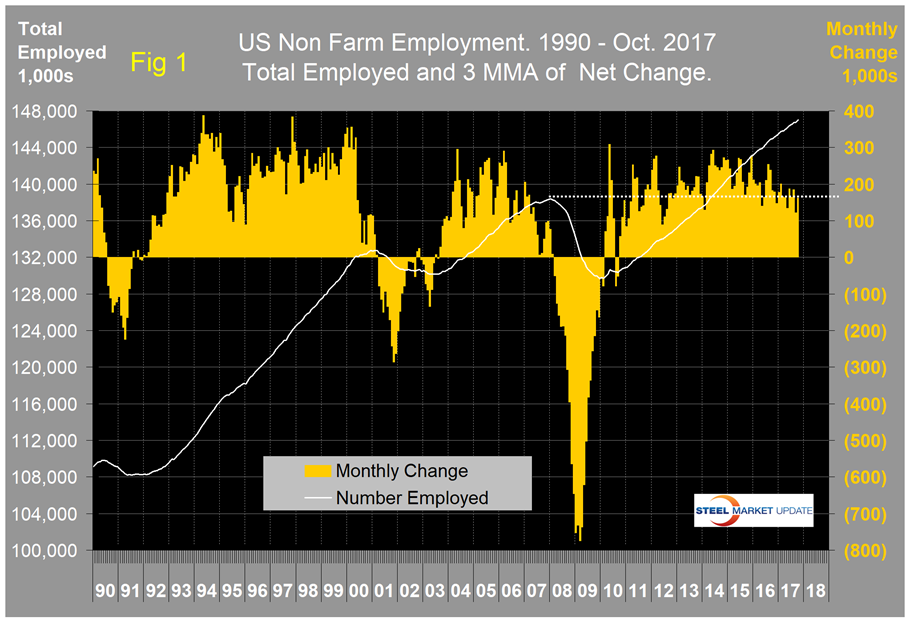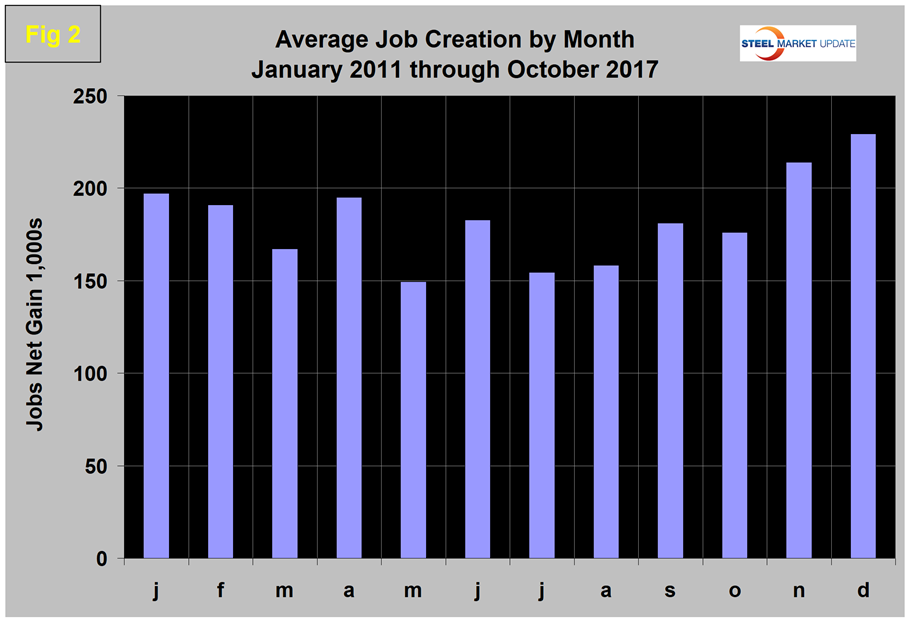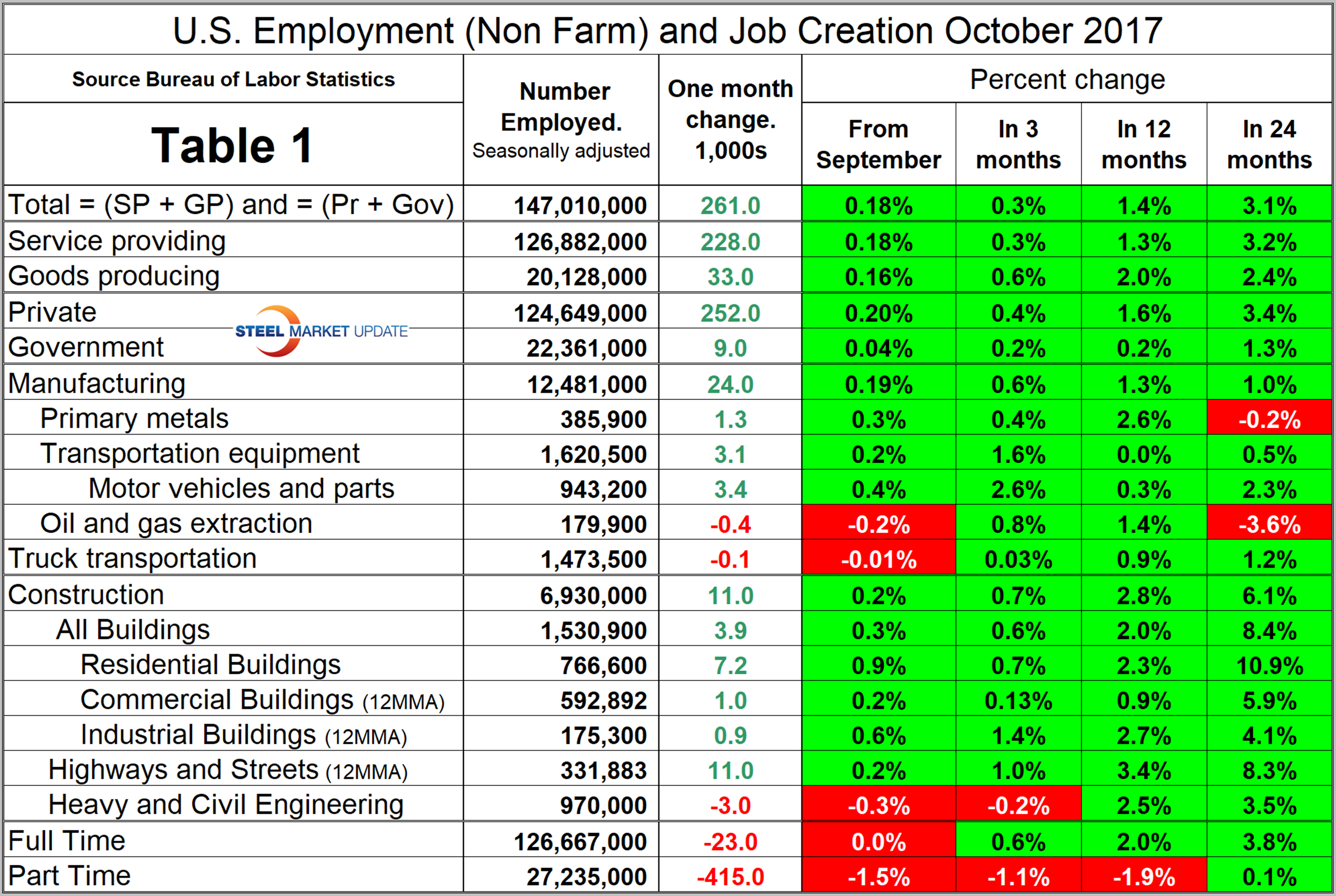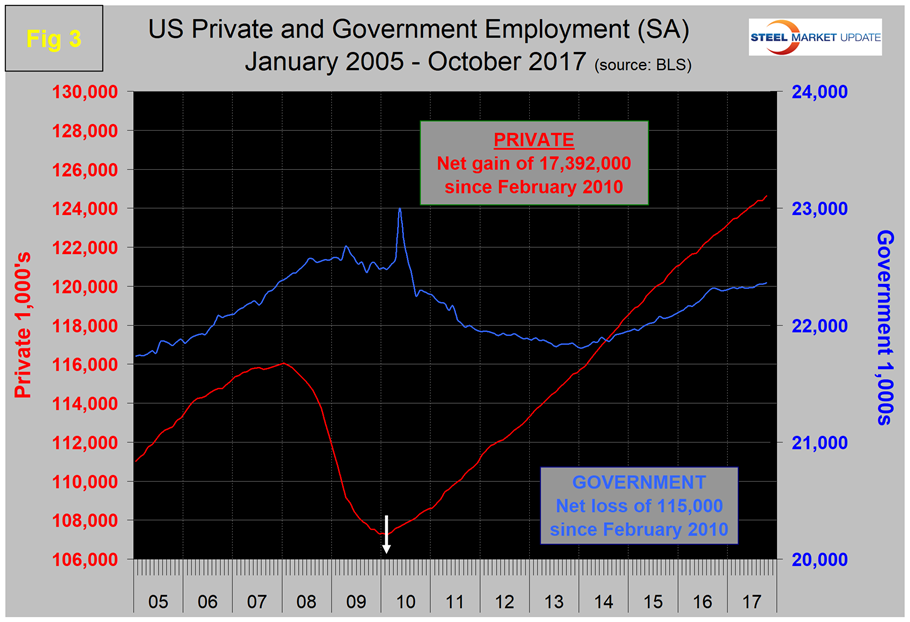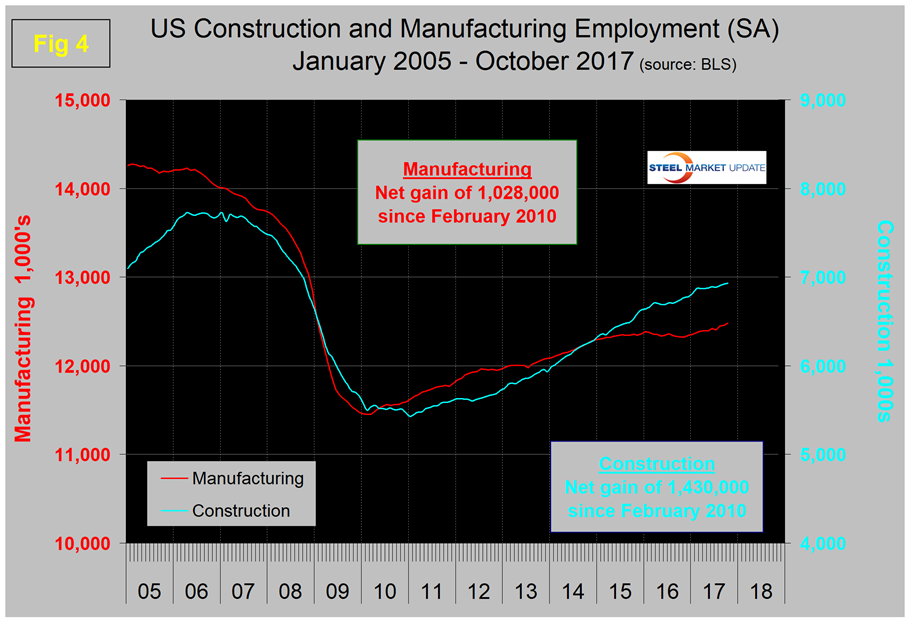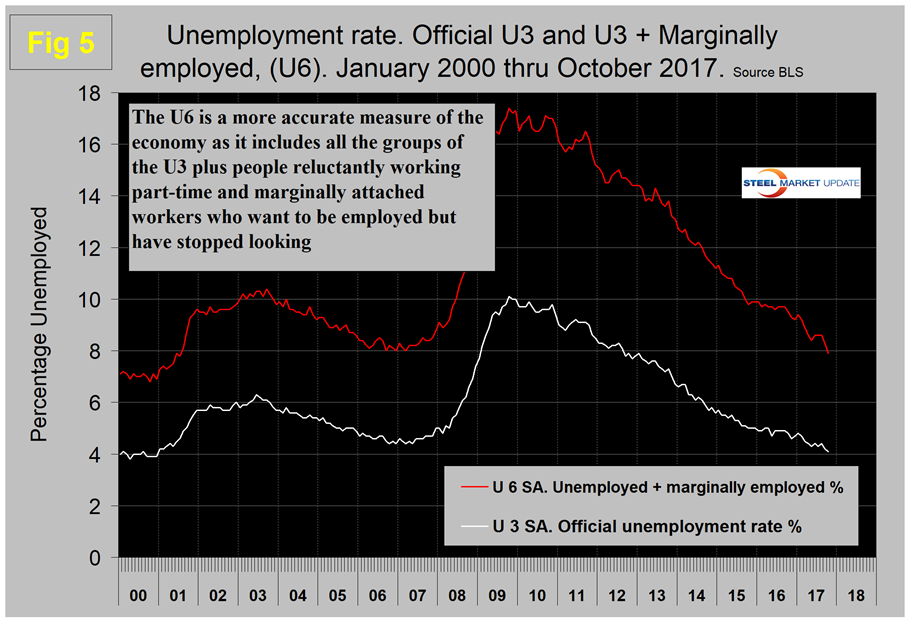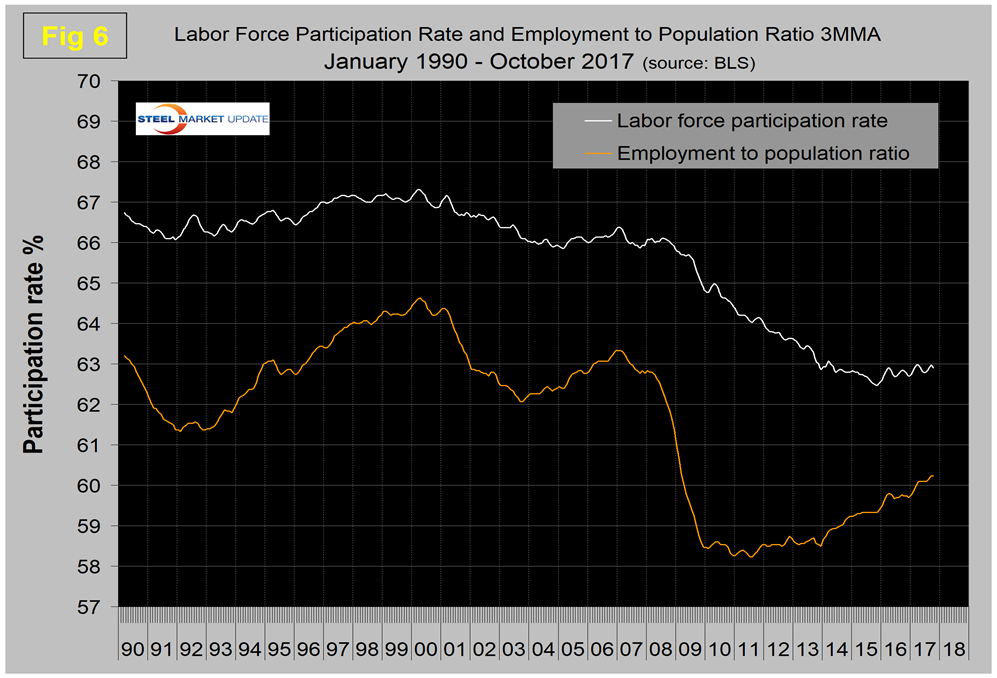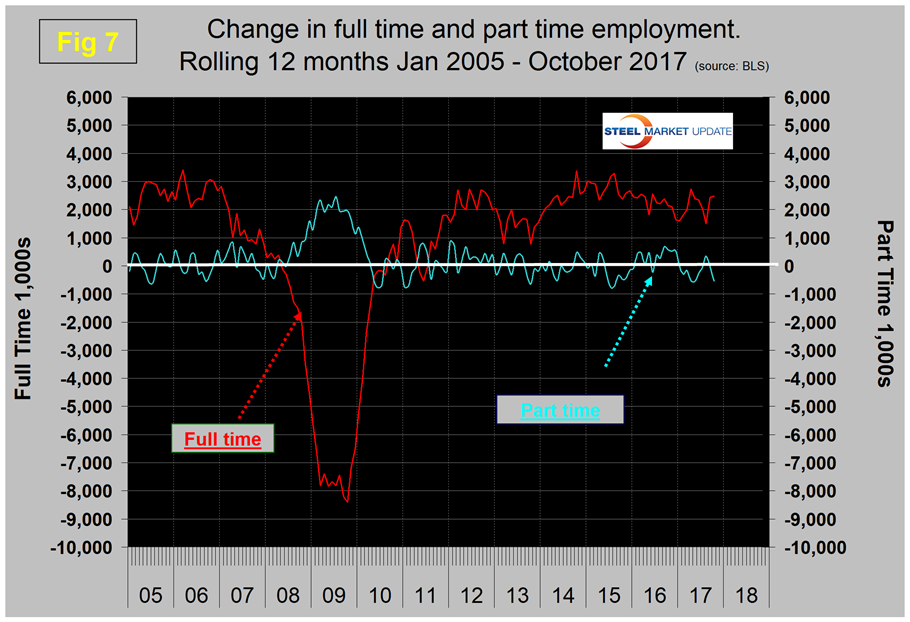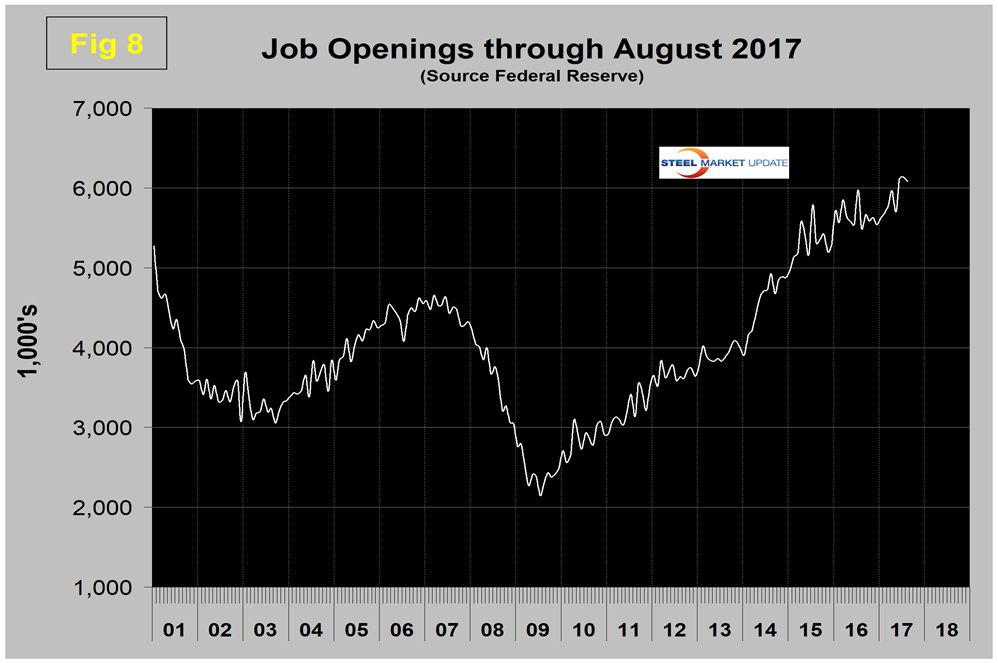Market Data

November 6, 2017
Job Creation Rebounds from Hurricanes
Written by Peter Wright
U.S. job creation rebounded in October from the blow it suffered in September due to the hurricanes, reports the Bureau of Labor Statistics (BLS) in its employment report released on Friday.
September hiring was severely affected by the Texas and Florida hurricanes, particularly in the hospitality industries in Florida. The October rebound was weaker than expected with a gain of 261,000 positions. The September result was revised up from negative 33,000 in the first estimate to positive 18,000 in the latest release. August was revised up by 39,000. Using a three-month moving average (3MMA), the October result was 162,000, up from 121,000 in September.
Economy.com summarized as follows: “The recovery from hurricanes, which depressed payrolls in September, was smaller than we had expected. Payrolls advanced by 261,000, but September’s losses turned into a modest gain of 18,000. As expected, the big loss in leisure/hospitality in September, revised to 102,000, was reversed with an October gain of 106,000. The unemployment rate declined to a new post-recession low of 4.1 percent due primarily to a large decline in the labor force. Accordingly, the participation rate fell 0.4 percentage point to 62.7 percent.
Figure 1 shows the 3MMA of the number of jobs created monthly since 1990 as the brown bars and the total number employed as the white line.
These numbers are seasonally adjusted by the BLS, which has been criticized in the past for the ineffectiveness of its seasonal adjustment calculations. In order to examine if any seasonality is left in the data after adjustment, we have developed Figure 2. In the seven years since and including 2011, job creation in October has been down by 3.0 percent. We can expect November and December to both increase.
Total nonfarm payrolls are now 8,645,000 more than they were at the pre-recession high of January 2008. November 2014 was the first month for total nonfarm employment to exceed 140 million, and in October was 147.0 million. The BLS reported that the average workweek for all employees on private nonfarm payrolls was unchanged at 34.4 hours in October. In manufacturing, the workweek increased by 0.2 hour to 41.0 hours, and overtime edged up by 0.1 hour to 3.5 hours. The average workweek for production and nonsupervisory employees on private nonfarm payrolls edged up by 0.1 hour to 33.7 hours. Average hourly earnings for all employees on private nonfarm payrolls, at $26.53, were little changed in October (-1 cent), after rising by 12 cents in September. Over the past 12 months, average hourly earnings have increased by 63 cents, or 2.4 percent. In October, average hourly earnings of private-sector production and nonsupervisory employees, at $22.22, were little changed (-1 cent).
Table 1 breaks total employment down into service and goods-producing industries and then into private and government employees. Most of the goods-producing employees work in manufacturing and construction, and the components of these two sectors that we consider to be of most relevance to steel people are broken out in Table 1.
In October, 252,000 jobs were created in the private sector and government gained 9,000 jobs. The number employed by the federal government gained 5,000 to 2.8 million; state governments gained 2,000 for a total of 5.09 million; and local governments also gained 2,000 to a total of 14.46 million. Since February 2010, the employment low point, private employers have added 17,392,000 jobs as government has shed 115,000 (Figure 3).
In October, service industries expanded by 228,000 as goods-producing industries, driven mainly by construction and manufacturing, expanded by 33,000. Since February 2010, service industries have added 14,776,000 and goods-producing 2,501,000 positions. This is part of the reason why wage growth has been slow since the recession, as service industries on average pay less than goods-producing industries such as manufacturing.
In October, manufacturing gained 24,000 positions; manufacturing has had only one losing month since October last year. In the first 10 months of 2017, manufacturing has gained 138,000 jobs and is 1.3 percent higher than the same month in 2016. Table 1 shows that primary metals gained 1,300 jobs in October, and is up by 10,100 year to date. Motor vehicles and parts industries gained 3,400 jobs in October. Trucking had strong growth in both February and March, but in the first 10 months of 2017 has had six losing months. Oil and gas extraction has been stalled since August last year with only a 2,000-job net gain in that time frame. Note that the subcomponents of both manufacturing and construction shown in Table 1 don’t add up to the total because we have only included those we think have most relevance to the steel industry.
Construction was reported to have gained 11,000 jobs in October and is up by 187,000 in the last 12 months, or 2.8 percent. Some of the major construction subcategories are routinely reported one month in arrears, which distorts the data in Table 1. These include industrial buildings, commercial buildings and highways and streets. Construction has added 1,420,000 jobs and manufacturing 1,028,000 since the recessionary employment low point in February 2010 (Figure 4).
Construction has leapt ahead of manufacturing as a job creator, but the growth of construction productivity is very low (or non-existent), in contrast to manufacturing where it has been historically high. The difference is the difficulty of automating construction jobs.
The official unemployment rate, U3, reported in the BLS Household survey (see explanation below), came in at 4.1 percent, which was down from 4.8 percent in October last year. This number doesn’t account for those who have stopped looking. The more comprehensive U6 unemployment rate was down from 9.7 percent in October last year to 7.9 percent in this latest report (Figure 5).
U6 includes workers working part-time who desire full time work and people who want to work but are so discouraged they have stopped looking. The differential between these rates was usually less than 4 percent before the recession, and in October fell below 4.0 percent for the first time since March 2008.
The employment participation rate at 62.7 percent in October was down slightly from 62.8 percent in October last year. We’re not sure what this is a percentage “of” because of the multiple descriptions of the labor pool. Another measure is the number employed as a percentage of the population, which we think is much more definitive. In October, this measure was 60.2 percent, up from 59.7 percent in October last year and from 59.3 percent in October 2015. The employment-to-population ratio stalled for most of last year, but has made progress in 2017. Figure 6 shows both measures on one graph.
In the 34 months since and including January 2015, there has been an increase of 6,756,000 full-time and a gain of 144,000 part-time jobs. Figure 7 shows the rolling 12-month total change in both part-time and full-time employment.
This data comes from the household survey and part-time is defined as less than 35 hours per week. Because the full-time/part-time data comes from the household survey and the headline job creation number comes from the establishment survey, the two cannot be compared in any particular month. To overcome the volatility in the part-time numbers, we have to look at longer time periods than a month or even a quarter, which is why we look at a rolling 12 months for this component of the employment picture shown in Figure 7.
The job openings report known as JOLTS is reported on about the 10th of the month by the Federal Reserve and is over a month in arrears. Figure 8 shows the history of unfilled job openings through August when openings stood at 6,082,000, not far off the all-time high of 6,116,000 in June this year. There has been an improving trend since mid-2009.
Initial claims for unemployment insurance, reported weekly by the Department of Labor, have flattened this year at the lowest level since 1974. In the week ending Oct. 28, initial claims were 229,000 with a four-week moving average of 232,500 claims. This marks the longest streak since 1973 of initial claims below 300,000 (Figure 9). The four-week moving average of initial claims (a better indicator of the trend than the weekly number) fell by 5,000 from the previous week’s revised average to 232,500 in the week ended Oct. 28. This is the lowest level for the four-week average since April 7, 1973.
The last piece of the employment puzzle that we examine is the Challenger report, which measures job cuts monthly (Figure 10). This data also tends to be quite erratic, therefore we examine a rolling 12 months and can see that job cuts decreased for most of 2016 and continued their downward trend in 2017. Year to date, retail has had the highest level of job cuts with a total of 72,600 cuts announced through October, up 36.7 percent from the same period last year.
SMU Comment: Job openings are close to an all-time high, new claims for unemployment are at a 44-year low, employers are hanging onto their people, manufacturing employment is 1.3 percent higher than this time last year and construction is up 2.8 percent. The employment situation has been described as “full” by some analysts. October was the 84th consecutive month of job growth, but Figure 1 shows a slowing trend since the middle of 2014. If as reported there is a shortage of qualified employees, we can expect an increase in wage-driven inflation in the near future. The results for manufacturing and construction are sign posts for steel sales activity. 2017 is heading strongly for the finish line.
Explanation: On the first Friday of each month, the Bureau of Labor Statistics releases the employment data for the previous month. Data is available at www.bls.gov. The BLS reports on the results of two surveys. The Establishment survey reports the actual number employed by industry. The Household survey reports on the unemployment rate, participation rate, earnings, average workweek, the breakout into full-time and part-time workers, and lots more details describing the age breakdown of the unemployed, reasons for and duration of unemployment. At SMU, we track the job creation numbers by many different categories. The BLS database is a reality check for other economic data streams such as manufacturing and construction, and we include the net job creation figures for those two sectors in our “Key Indicators” report. It is easy to drill down into the BLS database to obtain employment data for many subsectors of the economy. For example, among hundreds of sub-indexes are truck transportation, auto production and primary metals production. The important point about each of these hundreds of data streams is in which direction they are headed. Whenever possible, we at SMU try to track three separate data sources for a given steel-related sector of the economy. We believe this gives a reasonable picture of market direction. The BLS data is one of the most important sources of fine-grained economic data that we use in our analyses. The states also collect their own employment numbers independently of the BLS. The compiled state data compares well with the federal data. Every three months, SMU examines the state data and provides a regional report that indicates strength or weakness on a geographic basis. Reports by individual state can be produced on request.



